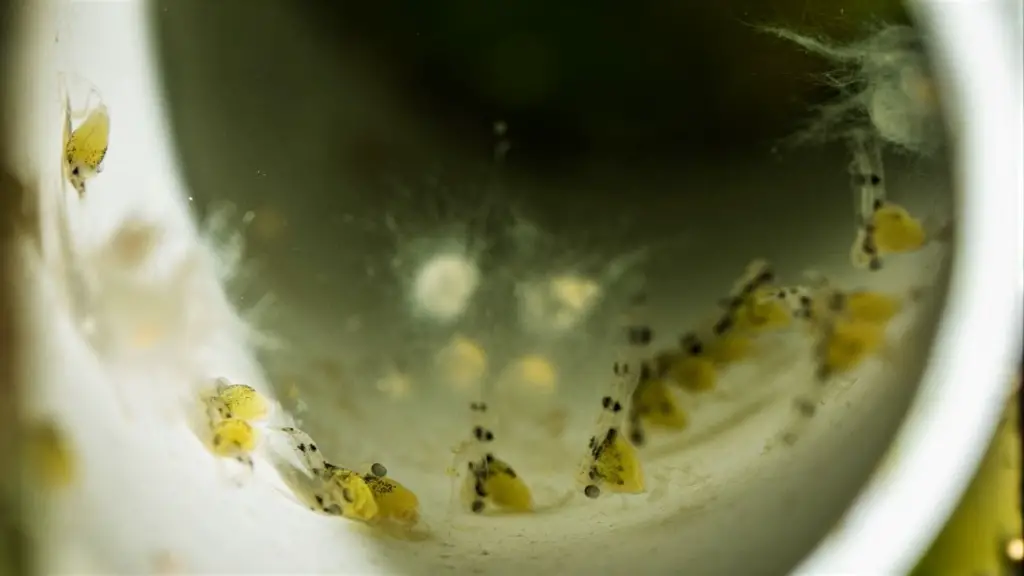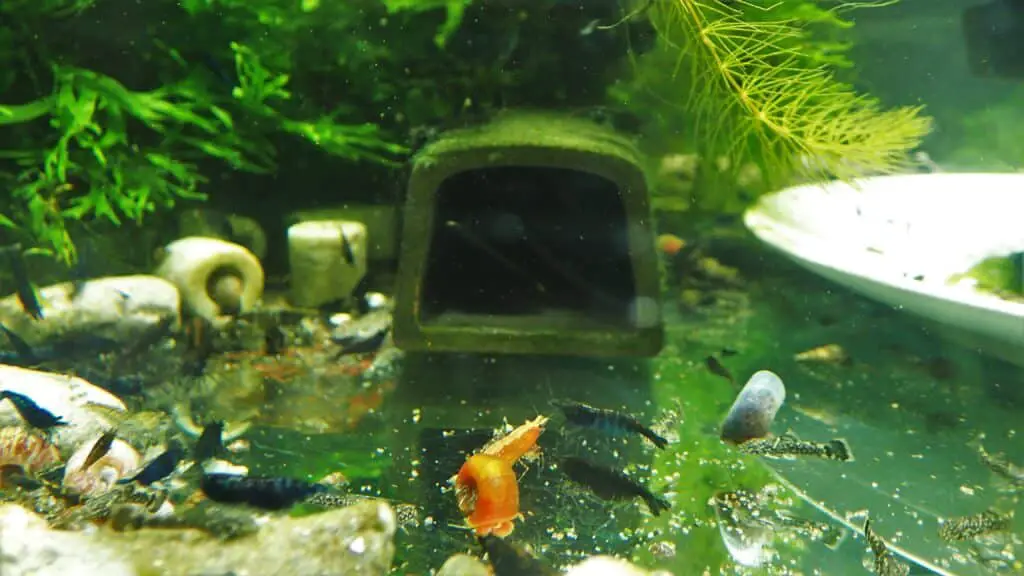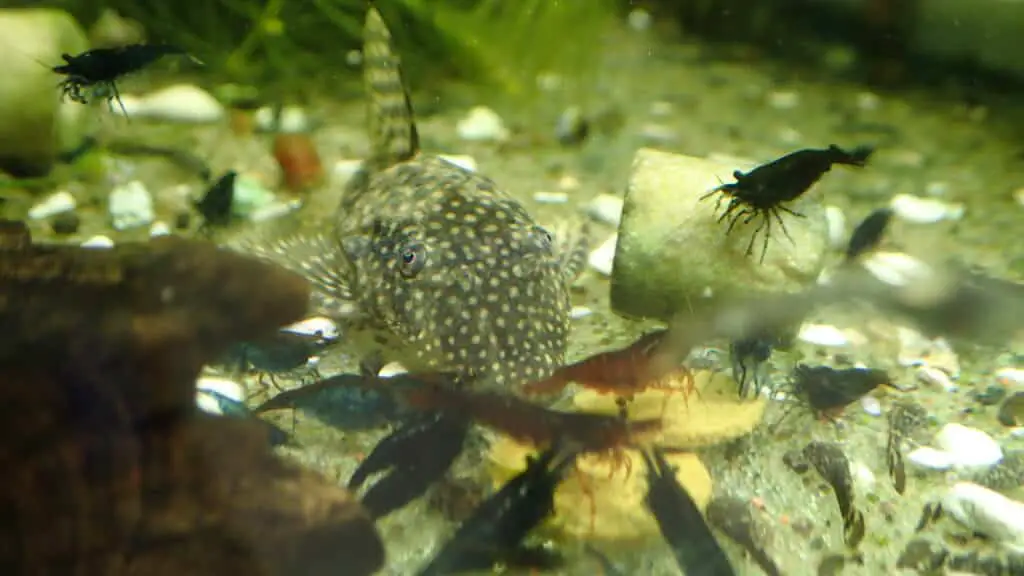Shrimp, in general, do not eat healthy fish eggs. They are more inclined to consume decaying organic matter, which can include fish eggs that are already unhealthy or dying. The notion that shrimp are aggressive egg predators is largely a misconception.
As an aquarist with a particular fondness for shrimp, I’ve often found myself fielding the question, “Do shrimp eat fish eggs?” It’s a query that has stirred up many a discussion among fellow shrimp enthusiasts. The answer, however, isn’t as cut-and-dried as some might hope. While shrimp are indeed opportunistic feeders, they typically do not target healthy fish eggs. Instead, their diet leans more towards decaying organic matter, which can encompass fish eggs that are already in a state of decline. In this article, we’ll delve into the dietary preferences of shrimp, debunk some widespread misconceptions, and provide insights on how to create a balanced aquatic environment for both your shrimp and fish.
Unraveling the Dietary Habits of Shrimp
Shrimp are primarily detritivores, which is a fancy way of saying they eat detritus – the decaying plant and animal matter that accumulates on the bottom of the tank. They’re not picky eaters by any means. They’ll happily munch on leftover fish food , algae, dead plant matter, and even the occasional dead fish.
, algae, dead plant matter, and even the occasional dead fish.
However, it’s important to note that shrimp are opportunistic feeders. This means they’ll eat just about anything that’s available to them, including decaying fish eggs. But don’t let this give you the wrong idea. Shrimp are not active predators and they don’t go hunting for fish eggs. They simply take advantage of the resources available to them in their environment.
In fact, shrimp play a vital role in maintaining the health of the aquarium ecosystem. By consuming decaying matter, they help to prevent the build-up of harmful bacteria and toxins that could negatively impact the other inhabitants of the tank. So, while it might seem like shrimp are always eating, they’re actually doing important work to keep your aquarium clean and healthy.
Shrimp are not the egg-eating villains they’re sometimes made out to be. They’re simply doing their job, cleaning up the tank and consuming whatever food resources are available to them. So, the next time you see your shrimp nibbling away at the bottom of the tank, remember that they’re just doing their part to keep your aquarium environment in tip-top shape.

Debunking the Myth: Do Shrimp Prey on Healthy Fish Eggs?
Shrimp are opportunistic feeders, which means they consume what’s readily available in their environment. However, their primary diet consists of detritus, algae, and leftover food particles. Healthy fish eggs, on the other hand, are not a typical part of their menu.
Why, then, does this myth persist? The confusion likely stems from observations of shrimp eating unhealthy or decaying fish eggs. When a fish egg begins to decay, it becomes part of the detritus in the tank – the very stuff that shrimp love to eat. In these instances, shrimp are not hunting down the eggs but rather cleaning up the tank, as is their nature.
It’s also worth noting that healthy fish eggs are usually well-protected. Many fish species guard their eggs or hide them in places that are difficult for shrimp to reach. So, even if a shrimp wanted to snack on a healthy fish egg (which they don’t), they would have a hard time getting to them.
The notion that shrimp prey on healthy fish eggs is a myth. Shrimp are more like the janitors of the aquarium, cleaning up waste and detritus, which can include decaying fish eggs. They’re not the egg-eating villains they’re often portrayed as, but rather essential contributors to a healthy and balanced aquatic ecosystem.
The Role of Shrimp in an Aquatic Ecosystem
One of the primary roles of shrimp in an aquarium is that of a cleaner. They are detritivores, meaning they feed on detritus – the decaying plant and animal matter that settles on the bottom of the tank. By consuming this material, shrimp help to prevent the build-up of harmful bacteria and toxins that could negatively impact the other inhabitants of the tank.
Shrimp also contribute to the control of algae in the tank. They are known to feed on various types of algae, helping to keep it in check and prevent overgrowth. This is particularly beneficial in planted aquariums, where unchecked algae growth can compete with plants for nutrients and light.
In addition, shrimp can contribute to the overall biodiversity of the tank. They often coexist peacefully with a variety of fish and plant species, adding to the dynamic and balance of the ecosystem. Their presence can also provide enrichment for other tank inhabitants, as they scuttle around the tank and interact with their environment.
Finally, shrimp can play a role in the nutrient cycle within the tank. As they consume detritus and excrete waste, they help to recycle nutrients within the ecosystem. This can contribute to the health and growth of plants within the tank, as well as the overall stability of the ecosystem.
Shrimp are not just decorative additions to an aquarium. They are hardworking members of the aquatic community, playing a vital role in maintaining the health and balance of the ecosystem. So, the next time you watch your shrimp scuttling around the tank, remember their important work to keep your underwater world in balance.

Creating a Harmonious Aquarium for Shrimp and Fish
Creating a harmonious aquarium where both shrimp and fish can thrive requires a delicate balance. It’s like conducting an underwater symphony, where each creature plays its part and contributes to the overall harmony of the ecosystem. Here are some key considerations to keep in mind.
Firstly, it’s important to choose compatible species. Not all fish and shrimp species can coexist peacefully. Some fish may see shrimp as a tasty snack, while others might be intimidated by the presence of shrimp. Researching the behavior and compatibility of different species is crucial before introducing them into the same tank.
Secondly, providing adequate hiding spots is essential. Shrimp, being small and often defenseless, appreciate places where they can retreat and hide from larger tank mates. This can be achieved by including plants, rocks, and other forms of aquarium decor that create nooks and crannies for shrimp to hide in.
Water quality is another critical factor. Both fish and shrimp require clean, well-oxygenated water to thrive. Regular water changes, along with a good filtration system, can help maintain optimal water conditions. It’s also important to monitor water parameters such as temperature, pH, and hardness, as both shrimp and fish can be sensitive to changes in these conditions.
Feeding is another area that requires careful attention. While shrimp can help clean up leftover food, they also need a diet rich in nutrients to thrive. Specialized shrimp food, along with occasional treats like blanched vegetables, can help ensure your shrimp get the nutrition they need.
Lastly, remember that patience is key. Establishing a balanced, harmonious aquarium takes time. It’s not uncommon for there to be a period of adjustment as new inhabitants get used to their surroundings and each other.
Creating a harmonious aquarium for shrimp and fish is a rewarding endeavor that requires careful planning, ongoing maintenance, and a keen understanding of the needs and behaviors of the inhabitants. But with patience and dedication, you can create a vibrant, balanced ecosystem that provides a fascinating window into the underwater world.

The Impact of Shrimp on Fish Breeding in Home Aquariums
When it comes to fish breeding in home aquariums, the presence of shrimp can raise some eyebrows. After all, we’ve already debunked the myth that shrimp prey on healthy fish eggs. But what impact do shrimp actually have on fish breeding? Let’s dive into this topic.
First and foremost, it’s important to understand that shrimp are generally peaceful tank inhabitants. They are not known to disturb fish during the breeding process. In fact, their presence can contribute to a more balanced and diverse ecosystem, which can indirectly support the overall health and well-being of breeding fish.
However, as we’ve discussed, shrimp are opportunistic feeders and may consume decaying or unhealthy fish eggs. This is not a predatory behavior, but rather a part of their role as cleaners of the aquarium. They help to prevent the build-up of decaying organic matter, which could potentially lead to the growth of harmful bacteria or fungi.
In some cases, the presence of shrimp can actually be beneficial for fish breeding. For example, some aquarists have observed that certain fish species seem to breed more readily in the presence of shrimp. This could be due to a variety of factors, such as the shrimp’s role in maintaining water quality or the added complexity they bring to the tank environment.
That being said, it’s always important to monitor your tank closely during the breeding period. If you notice any issues, such as shrimp showing too much interest in the breeding area, it may be necessary to separate the shrimp from the fish temporarily.
While shrimp can have an impact on fish breeding in home aquariums, it’s generally not a negative one. They do not actively disturb breeding fish or prey on healthy eggs. Instead, they contribute to the overall health and balance of the aquarium, which can indirectly support successful fish breeding. As with any aspect of aquarium keeping, careful observation and understanding of your tank’s unique dynamics are key.
Conclusion
In the world of aquarium keeping, shrimp are often misunderstood creatures. They are not the egg-eating predators some believe them to be. Instead, they are peaceful, hardworking members of the aquatic community, playing a vital role in maintaining the health and balance of the ecosystem. They coexist peacefully with many fish species and can even indirectly support fish breeding by contributing to a balanced and diverse tank environment. So, if you’ve been hesitant about adding shrimp to your aquarium, I hope this article has helped to dispel some of your concerns.
Remember, every aquarium is unique, and understanding the dynamics of your specific tank is key to creating a harmonious environment for all its inhabitants. If you need any help or have any questions, please don’t hesitate to contact me. Happy Shrimp Keeping!
FAQ: Do Shrimp Eat Fish Eggs?
Q: Will shrimp eat eggs?
A: Shrimp do not typically eat healthy eggs, whether they’re from fish or other creatures. They are more likely to consume decaying organic matter, which can include eggs that are already unhealthy or dying.
Q: Do shrimps eat baby fish?
A: Shrimp are generally not predators and do not actively hunt or eat baby fish. They are detritivores, primarily feeding on detritus and algae in the tank.
Q: Do cherry shrimp eat guppy fry?
A: Cherry shrimp are peaceful creatures and do not typically eat guppy fry. They are more interested in algae, detritus, and leftover food particles.
Q: Can shrimp live with fish fry?
A: Yes, shrimp can coexist peacefully with fish fry in the same tank. However, it’s important to provide enough hiding spots and monitor the tank closely to ensure the safety of the fry.
Q: Are shrimp good for fish tanks?
A: Absolutely! Shrimp play a vital role in maintaining the health and balance of the aquatic ecosystem. They help clean the tank by consuming decaying plant and animal matter and controlling algae growth.
Q: Will Amano shrimp eat fish fry?
A: Amano shrimp, like most shrimp species, are not predatory and do not typically eat fish fry. They primarily feed on algae and detritus in the tank. However, it’s always important to monitor your tank closely to ensure the safety of all inhabitants.
